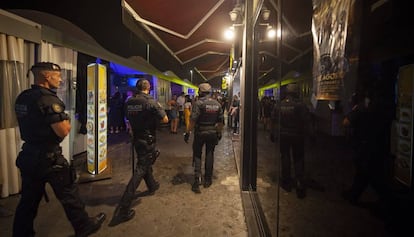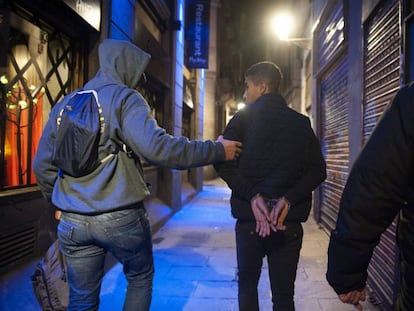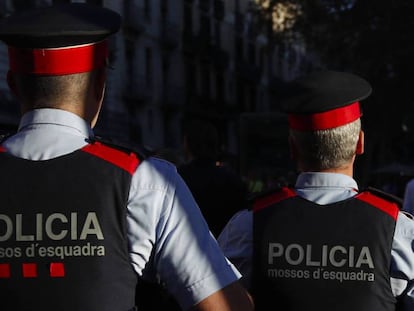“Packs of youngsters” behind new wave of Barcelona street crime, say police
The regional force has created a special group to fight against reoffending youth gangs in the Catalan capital, which has seen a sharp spike in violent robberies


Friday evening on an August day in Barcelona. A group of half-a-dozen youths pounces on a tourist in an attempt to steal his watch on the seafront promenade in Joan de Borbó. A plain-clothes officer from the Catalan regional police force, the Mossos d’Esquadra, gets on the scene in time to apprehend one of them. The youngster resists arrest, and the two, thief and policeman, end up with bruises. The tourist is taken to hospital, likely with a broken hand. The police manage to get the watch back, although it is broken. The rest of the gang disappears from the scene, including the actual thief himself.
This is the kind of crime that the Mossos are trying to combat in Barcelona. “It’s a new paradigm,” explain police sources. “They’re packs of youngsters that go out to hunt.” The same sources blame these gangs for the rise in violent crimes committed in the center of Barcelona – around 40 a day, between those seen in the streets, in establishments and muggings – that has been detected in recent months. “It’s their way of life,” they add.
From a group of eight, you can catch three of them, but they might not even be the actual thieves
Catalan police sources
In May, the Catalan police established a specific team – called Poliédrico, meaning “multifaceted” – that is dedicated to monitoring the steps of these youngsters, most of whom are unaccompanied migrants under the age of 18, and others who are adults. Analysis of their work has produced a “top 22” list of youngsters who have an average of 15 arrests or complaints against them, according to data presented at the last Local Security Committee in Barcelona. Some of these youngsters have been arrested more than 30 times.
“It’s very difficult to take action against them,” explain police sources. The usual parameters applied to catch thieves who plan their jobs, or pickpockets who operate to avoid violence, cannot be used here. They swarm through the center of the city, and when the want to, they steal together. “From a group of eight, you can catch three of them, but they might not even be the actual thieves, nor can you get back what they’ve stolen,” the same sources explain. This complicates gathering evidence against them and means that it is hard to have them locked up in pre-trial custody. Just 10% of those arrested for violent robberies this year have been held in custody – 165 of 1,529 detainees up to August 14.
The current wave of violent street robberies is creating a sense of insecurity in Barcelona, but they account for just 3.6% off all offenses, coming in at 115,014 in the year up to June, 9% up on last year’s figures. The majority of registered crimes in the Catalan capital are thefts, accounting for half of the total and coming in at around 365 a day on average. Violent robberies in people’s homes, meanwhile, have fallen by 16%.
Barcelona has a problem and it can’t be covered up
Josep Cid, coordinator of Criminology studies at the Autonomous University of Barcelona (UAB)
“Barcelona has a problem and it can’t be covered up,” explains Josep Cid, coordinator of Criminology studies at the Autonomous University of Barcelona (UAB). But he believes that the rest of Spain is also seeing a small rise in crime, with an 8.5% increase in violent robberies in the year up to March, according to the latest figures available from the Interior Ministry. Sexual violence is also on the rise, although experts attribute this to increased social awareness and a greater likelihood of victims reporting such offenses.
Whatever the case, Barcelona is at the top of the list for worsening crime statistics, with a 17% rise in registered offenses in 2018. Cid has no doubt that this is partly due to the “deterioration of living conditions” in the Raval neighborhood, in the center of the city – its district, Ciutat Vella, is where half of all thefts and violent robberies take place. “We need to make policies to avoid this, and fight so that the degradation doesn’t get worse and locals get involved,” he adds. He also warns of the risk of “crime being seen as an opportunity in the neighborhood.”
Diego Torrent, a doctor in Sociology at the University of Barcelona, argues that there is “no other alternative criminal phenomenon that has changed so much to explain the figures” in the Catalan capital than the arrival of migrant minors, with a care system that is “overwhelmed” and trying to “palliate exclusion.” The majority of these migrants do not commit offenses, according to data from the Mossos d’Esquadra, but those who do are highly likely to reoffend.
And why has this phenomenon not been seen in other cities that have also taken in these minors? Torrente points to the “environmental and social disorders that overlap” in Barcelona, such as the high rates of tourism and street hawking, which “have created a less-cohesive environment, weakening informal social controls.”
Two capitals with few homicides
Crime rates in Madrid and Barcelona have grown in the first quarter of the year, according to data from the Interior Ministry, rising 7.6% and 12%, respectively. With differing populations, areas and pressure from tourists, both regional capitals have identical homicide rates according to the data – 0.6 for every 100,000 inhabitants. This figure is within the Spanish average, which is one of the lowest in Europe. The big difference in the statistics is when it comes to violent robberies, with 312.9 for every 100,000 inhabitants in Madrid, compared to 757.6 in Barcelona. Experts point to tourism as one of the factors behind this, given that 30 million visitors spend just a day or more than one night in the Catalan capital every year. Some 22% of the victims of all of the offenses in the city are tourists, police sources explain. In both cities, minor thefts account for nearly half of all offenses committed on the streets.
English version by Simon Hunter.
Tu suscripción se está usando en otro dispositivo
¿Quieres añadir otro usuario a tu suscripción?
Si continúas leyendo en este dispositivo, no se podrá leer en el otro.
FlechaTu suscripción se está usando en otro dispositivo y solo puedes acceder a EL PAÍS desde un dispositivo a la vez.
Si quieres compartir tu cuenta, cambia tu suscripción a la modalidad Premium, así podrás añadir otro usuario. Cada uno accederá con su propia cuenta de email, lo que os permitirá personalizar vuestra experiencia en EL PAÍS.
¿Tienes una suscripción de empresa? Accede aquí para contratar más cuentas.
En el caso de no saber quién está usando tu cuenta, te recomendamos cambiar tu contraseña aquí.
Si decides continuar compartiendo tu cuenta, este mensaje se mostrará en tu dispositivo y en el de la otra persona que está usando tu cuenta de forma indefinida, afectando a tu experiencia de lectura. Puedes consultar aquí los términos y condiciones de la suscripción digital.
More information
Archived In
Últimas noticias
Maduro pleads not guilty before the federal court in New York: ‘I am still the president of Venezuela’
A new test can detect Alzheimer’s from a finger prick
UN team enters Sudanese city of El Fasher after paramilitary massacre: ‘It’s like a ghost town’
A recipe for resistance: Indigenous peoples politicize their struggles from the kitchen
Most viewed
- Gilles Lipovetsky: ‘If you want to live better and fall in love, take Prozac, don’t look to philosophy’
- Alain Aspect, Nobel laureate in physics: ‘Einstein was so smart that he would have had to recognize quantum entanglement’
- Alvin Hellerstein, a 92-year-old judge appointed by Bill Clinton, to preside over Maduro’s trial in New York
- Maduro’s downfall puts China’s relationship with Venezuela to the test
- Why oil has been at the center of Venezuela-US conflicts for decades










































